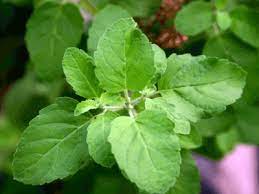
Flowering plant of the mint family grown for its aromatic leaves. Holy basil is native to the Indian subcontinent and grows in Southeast Asia. Ayurvedic and traditional medicine, often as tea leaves for various ailments, are considered sacred in Hinduism. It is considered an agricultural and Invasive species in some areas outside its native range.
Holy basil is an erect, many-branched subshrub, 30–60 cm (12–24 in) tall with hairy stems. Leaves are green or purple; they are simple, petioled, with an ovate blade up to 5 cm (2 in) long, which usually has a slightly toothed margin; they are strongly scented and have a decussate phyllotaxy. The purplish flowers are placed in close whorls on elongated racemes.]
The three main morphotypes cultivated in India and Nepal are Ram tulsi (the most common type, with broad bright green leaves that are slightly sweet), the less common purplish green-leaved (Krishna or Shyam tulsi) and the common wild vana tulsi.
The holy basil plant is a small annual or short-lived perennial shrub, up to 1 metre. The small purple or white tubular flowers have green or purple sepals and are borne in terminal spikes. Tulsi can lower blood sugar and should be used with caution in people who have diabetes and are on blood sugar-lowering
Health Benefits
Tulsi may help keep cholesterol in check, according to a 2006 study on rabbits. Improve digestion system. And reduce stress levels. Its importance in traditional medicine and its numerous health benefits. Make it a valuable addition to any wellness routine.
- Women who are pregnant or trying to become pregnant should not use tulsi as it may affect fertility, possibly due to its ursolic acid content.
